Construction Machinery
Construction machinery encompasses a wide range of equipment essential for various tasks in the building and civil engineering sectors. Some of the most common types include earthmoving machinery, lifting equipment, and material handling machinery.
Earthmoving machinery includes excavators, bulldozers, and backhoes. Excavators are versatile machines equipped with a boom and bucket, ideal for digging and material handling tasks. Bulldozers, with their broad blades, are used for grading, moving soil, and clearing land. Backhoes combine a front loader with an excavator arm, providing versatility for digging and loading tasks on smaller job sites.
Lifting equipment includes cranes and hoists. Cranes, such as tower cranes and mobile cranes, are used to lift and move heavy materials vertically and horizontally. Tower cranes are especially common on large construction sites, providing height and reach to construct tall buildings. Hoists, on the other hand, are more suited for smaller loads and vertical lifting applications.
Material handling machinery includes forklifts and telehandlers. Forklifts are designed to lift and move pallets and heavy materials within warehouses and construction sites. Telehandlers, or telescopic handlers, provide extended reach and versatility, allowing operators to lift loads to heights and distances that standard forklifts cannot achieve.
In addition to these categories, construction machinery also includes compaction equipment like rollers and pavers, which are crucial for preparing and finishing surfaces. The diversity of construction machinery ensures that specific tasks are performed efficiently and effectively, contributing to the overall success of construction projects.
What Factors Should Be Considered When Selecting Construction Machinery?
Selecting the right construction machinery for a project is critical to ensuring efficiency, safety, and cost-effectiveness. Several key factors should be considered when making this decision.
First, assess the type of work to be performed. Different machines are designed for specific tasks, so understanding the project's requirements is crucial. For example, if the project involves extensive earthmoving, an excavator or bulldozer may be necessary. Conversely, for lifting and placing heavy materials, a crane or telehandler would be more appropriate.
Second, consider the machine's capacity and specifications. Evaluate the weight and size of the materials to be handled, as well as the depth or height required for specific tasks. Each piece of machinery has defined limits regarding load capacity and reach, which must align with the project demands to avoid accidents and inefficiencies.
Third, analyze the project site conditions. Factors such as terrain, space limitations, and accessibility can greatly influence the choice of machinery. For example, compact or narrow sites may require smaller equipment or machines that can maneuver easily in tight spaces.
Fourth, evaluate the budget and cost implications. Consider not only the purchase or rental price but also operating costs, maintenance, and fuel efficiency. Selecting machinery that provides long-term value and reliability can help mitigate future expenses.
Finally, consider operator skill and experience. Ensure that your team is trained to operate the machinery safely and efficiently, as the right operator can make a significant difference in productivity and safety on the job site.
What Are The Safety Considerations When Using Construction Machinery?
Safety is paramount when operating construction machinery, as the potential for accidents and injuries is significant in this environment. Several key safety considerations must be prioritized to ensure the well-being of operators and workers on site.
First, operator training and certification are essential. All personnel operating machinery should receive proper training that covers equipment operation, safety protocols, and emergency procedures. Operators should be familiar with the specific machine they are using, including its controls, capabilities, and limitations.
Second, conducting pre-operation inspections is crucial. Before using any machinery, operators should perform thorough checks to ensure that the equipment is in safe working condition. This includes examining hydraulic systems, brakes, lights, and other critical components for wear or damage. Any issues should be reported and addressed before operation begins.
Third, maintaining clear communication among the crew is vital. Establishing a system of signals or using two-way radios can help ensure that all workers are aware of machinery operations, especially when lifting or moving heavy loads. Workers should also be positioned at a safe distance from the equipment in operation to prevent accidents.
Fourth, wearing appropriate personal protective equipment (PPE) is essential. Operators and ground personnel should wear hard hats, safety glasses, gloves, and steel-toed boots to protect against potential hazards.
Finally, understanding and following local regulations and guidelines is important. Compliance with safety standards set by organizations like OSHA (Occupational Safety and Health Administration) helps ensure a safe working environment. By prioritizing these safety considerations, construction sites can significantly reduce the risk of accidents and injuries.












